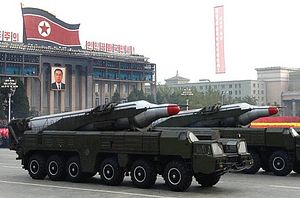On April 14, 2016, on the occasion of Kim Il-sung’s 104th birthday, North Korea tested its Musudan (BM-25) intermediate-range ballistic missile. The test failed. Two weeks later, it carried to two additional tests, both of which failed as well. Finally, a week ago, on May 31, it attempted a final Musudan test, which also failed as the missile exploded shortly after launch. In short, North Korea’s having a lot of trouble getting its Musudan IRBMs functional. What’s going on here?
Two North Korea watchers have presented interesting analysis on the recent spate of Musudan testing in North Korea. Notably, as John Schilling notes over at 38 North, North Korea has never carried out so many tests of a single missile system so frequently. The system has been known to exist for sometime, but has never been successfully tested. In fact, the April 14 test launch of the Musudan was meant to capstone several weeks of provocative testing and posturing from North Korea.
Following January’s nuclear test–Pyongyang’s fourth ever–and February’s satellite launch, North Korea’s Rodong Sinmun ran above-the-fold imagery showing Kim Jong-un inspecting a nose cone for a KN-08 intercontinental ballistic missile and a compact nuclear device (purportedly ready to mate with the KN-08 delivery system, which is also untested). Moreover, North Korean media showed off a solid fuel missile propulsion system and a reentry test for a nosecone.
No doubt, a failed IRBM test on the birthday of the Eternal President of the Republic was a source of embarrassment for North Korea. Until then, most of its testing had conveyed a sense of steady linear progress. Indeed, a lot of the testing we saw this spring affirmed that North Korea had learned a lot about the various components necessary for it to attain a credible nuclear deterrent–one of the pillars of Kim Jong-un’s byungjin line, the other being economic growth.
Moreover, as Tal Inbar notes in a post at NK News, the frequency of Musudan testing “for an outsider, looks like an emotional decision, not a rational one.” Missiles are hard and North Korea has in the past shown the maturity to take a few months and even years after failed missile tests to scientifically evaluate the cause of failure before another attempt. Missile experts observe that the Musudan is a reverse engineered North Korean derivative of the Soviet R-27/SS-N-06 Zyb, a fairly reliable submarine-launched ballistic missile (Schilling discusses this in more detail).
Schilling posits that the spate of testing–the three attempts at launches in April, at least–can be explained by extreme pressure on North Korean engineers ahead of the 7th Workers’ Party Congress, which came and went in early May. Regarding the May 31 test, Schilling speculates that Pyongyang could have been gearing up to send a message to China before the unexpected visit by the Ri Su-yong-led delegation last week (I discussed that in more detail here.)
The Workers’ Party Congress motivation is somewhat convincing. Though Kim didn’t announce any large-scale and explicit program of economic reform, he did outline a new five-year plan that contains hints of additional opening up to come. The economic reform per byungjin, of course, rests on the establishment of a successful nuclear deterrent. Schilling rightly notes that the Musudan’s “killer app” is its ability to bring the U.S. territory of Guam into the reach of North Korean missiles.
Had North Korea’s April tests succeeded, Kim would have been able enter the Congress with the ability to contend that under his watch, Pyongyang achieved a major milestone: bringing the territory of the United States under direct nuclear threat. Of course, the failed tests likely didn’t affect how Kim conducted himself during the Congress (or, rather, it’s unknowable what Kim might have done differently had the tests succeeded).
There’s an alternative more mundane explanation from Schilling: “Maybe the senior leadership has decided to leave Guam to the more capable and versatile KN-08 and KN-14 missiles now under development, or the GORAE-class ballistic missile submarine, and the Musudan engineers are desperately trying to prove their own worth.” With the KN-08, KN-14, and KN-11 (the SLBM to be delivered by North Korea’s lone ballistic missile submarine) facing their own issues, perhaps the regime saw the R-27-based Musudan to be the best bet.
Whatever the reason, it’s clear that North Korea desperately wants its Musudan IRBMs to fly successfully. No doubt, with four failed test attempts, the engineers at work on the system may finally head back to the drawing board for a long, hard look at whatever issues ail the system. As with most of its missile systems, Pyongyang has shown that it’s slowly but surely acquiring knowledge and improving on its capabilities.
The Musudan wasn’t ready for Kim Il-sung’s 104th birthday, but it may come around in time for the 105th.
































